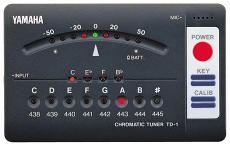

|
| Yamaha TD-1 (file photo) |
I had a different tuner before, one with an analog meter movement (which I like the idea of), but I hated it. It worked fine in a quiet room, but when in the band room with a lot of other playing going on (along with ambient noise) it was unable to lock onto me. It also was not a chromatic tuner, you had to transpose for a B♭ (or whatever) instrument if you wanted anything more out of it than just centering the needle on whatever note you happened to be on. (On the other hand it used the common 9V battery which lasted forever, had a real power switch, and had pass-through 'phone connectors for tuning guitars, using a microphone, etc.)
I bought the TD-1 at the local music store because the proprietor (whom I knew and had played with) said it worked very well, and it was a chromatic tuner and so would do the transposition for me. I was buying the piccolo trumpet at the time (late in 1998), and wanted something quick-reacting that read out the notes for me, so that as I played it could help train my ear on that treacherous beast. It worked well for this. The unit is small and light, the size of a cassette tape—it even uses a cassette tape case!
Yes, it worked fabulously, but its appetite for batteries was prodigious! And it wants two CR2025 watch batteries at a time, which are not cheap. It's rated for a mere 3 hours on a set! Ugh.
Disgusted after I put in the third set of batteries, I dove into it for a look-see. There was a spot along the edge of the case where I could cut in a small power jack. I bought a dead cell phone at the thrift shop and cut it up to get the jack, which I glued and soldered into place. I cut the power trace to the batteries and inserted it in series, so that if the jack was plugged in the batteries were disconnected. That was an undertaking, to say the least. (And a bit scary, because the tuner was not cheap.)
I was also able to make an external battery (for the trumpet case) that used a nominally-dead 2CR5 6 V battery (from the Canon EOS film cameras) and a miniature power plug with its wires jammed into the battery contacts. Though the battery would no longer operate a camera it still had plenty of juice left to run the tuner, and at a much higher capacity than the coin cells. And it was free, rescued from my dead battery recycling box.
I then got a transformer-based wall-wart with a suitable connector and voltage rating, and inserted a 5 V linear voltage regulator circuit. This was sub-optimal as the batteries added up to 6 V, but it's what I had on hand and the tuner seemed to work fine on it.
This all worked well. (After some time I sold the old tuner to a bandmate for use at home. I think I got $20.)
...Fast forward eleven years, and the tuner had begun to act up when on the wall-wart. It would lock onto spurious signals, apparently, and not tune me! (It worked fine on batteries.) Theorizing that it was noise on the power supply (I measured 66 mV of AC noise on it) I went back to the thrift shop, and this time got a 5.9 V switching power supply that was intended to charge a Motorola cell phone. I cut the weird plug off the end and flanged it into the cable from the first wall-wart and tested it. The tuner seemed to work better this way so I made the arrangement permanent. I joined both cords together in the middle, with solder and heat shrink tubing, so that the result was an extra-long cord. The old wall-wart went to the junkbox. [Later it returned to duty, powering a Christmas decoration.]
As this tuner seemed to end up permanently tethered in the music room (though it was still eminently portable) I'd been thinking about procuring a second one to keep in the trumpet case. Surprisingly enough even after eleven years they were still available new, though just barely. They'd gotten down to about $60 new, though I'd seen used ones in the $5–10 range. I really like this tuner model, because it works well and is not LCD-based. I would also consider one of the portable strobe tuners, if I found one I really liked. I'm not willing to spend money on one that I didn't get to try out, though, and the TD-1 has already passed its audition!
I did find a surplus site that had the coin batteries for cheap, so I bought a strip of ten. That'll last for awhile, if I'm careful.
When I broke down and tried to order another (new) tuner in 2010 I found that the supply had apparently just run dry. I was unable to find another new one, so I turned to eBay. Monday, July 26, 2010, I bid on (and won) one, about $14, shipped. This came Thursday, July 29, 2010 and went directly into the trumpet case, where it has been of good service.
...Daniel has taken up the bassoon in 5th-grade band, and I decided that he should have a tuner of his own for his instrument case. Another TD-1 finally turned up on eBay, about $30 this time. A little late for Christmas, but close enough...
...As of 2016, though, what I find I use for tuning most times is my iPhone running the Peterson iStroboSoft tuner software.